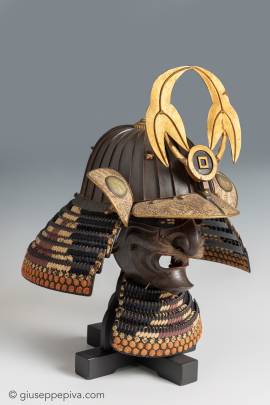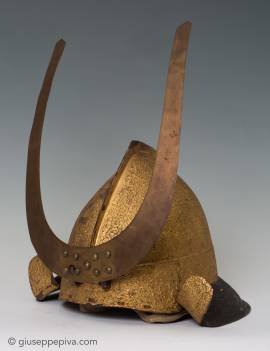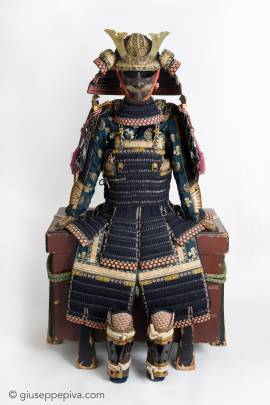Helmet and samurai maskEdo period, early 19th centurySignaturesKabuto: Nisshū ju KanemitsuMenpō: Sukemitsu The 32-plate helmet of suji-bachi type, consisting of 32 iron plates finished in sabiji-nuri, folded upward. On the diagonals are four shiten-no-byo rivets and related hibiki-no-ana.The menpō is beautifully finished, with sharp edges and meticulous decoration.Both the protection of the neck (shikoro) and that of the throat (tare) are bound with silk of three colors, echoing the omodaka (sagittaria leaf) motif popular between the twelfth and thirteenth centuries in ō-yoroi-type armor...
WORKS FOR SALE
DATEMomoyama period (1575 - 1615), late 16th centuryMEDIUMGilded iron A gold lacquer helmet of momonari shape. The single-plate shikoro is black lacquered and the original maedate is gilt. The momonari shape (peach-shaped) is inspired by European helmets, specifically designed to deflect the firearms’ bullets.This kind of helmet is well known: they had been made for the campaign of Korea (1592-98) in Kyushu island. The peculiarities of these helmets were that they did not belong to a single soldier but they were...
Samurai armourEdo period (1615-1867), 18th century SignatureThe menpō is signed under the chin 弘前住 明珍紀宗賢 盛吉作 (Hirosaki no Ju Myōchin ki Munekata Moriyoshi saku) CertificateThe armor accompanied by a certificate of registration as Jūyō Bunka Shiryō(Important cultural work)issued by the Nihon Katchu Bugu Kenkyu Hozon Kai (Association for the Research and Preservation of Japanese Helmets and Armor).Literature:Katchu Bugu Juyo Bunka Shiryo Zuroku - Vol. 4, (Tōken shunjû shinbunsha: Tōkyō, 2004), Pag. 76-77Description:The style of the armor is reminiscent of the medieval suits, as common...
Copyright © 2016 - giuseppe piva - VAT: 05104180962










